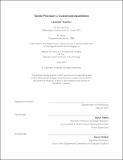Textile precision for customized assemblies
Author(s)
Tessmer, Lavender.
Download1135866913-MIT.pdf (13.29Mb)
Other Contributors
Massachusetts Institute of Technology. Department of Architecture.
Advisor
Skylar Tibbits.
Terms of use
Metadata
Show full item recordAbstract
With the potential to configure patterns and materials with stitch-level control, textiles are becoming an increasingly desirable method of producing mass customized items. However, current textile machines lack the ability to transfer three-dimensional information between digital models and production with the same level of control and accuracy as other machines. Designers are accustomed to generating three-dimensional objects in a digital model then converting these into instructions for machines such as 3D printers or laser cutters, but current design interfaces and production machines for textiles provide no comparable workflow for producing items that rely on precise control of physical size and fit. Customized assemblies-such as footwear or architectural projects with complex geometries--increasingly integrate textile components with parts produced through a variety of other industrial processes. Furthermore, there is growing interest in the use of three-dimensional data, such as 3D body scanning, to aid in the production of custom-fit products. As mass customization becomes more widespread as an alternative to mass production, general-purpose machines are increasingly capable of generating customized items with high efficiency, relying on design-to-machine workflows to control geometric changes. However, current textile machines are unable to adapt to changing geometric information with the same efficiency. The challenges to dimensional precision in textiles are wide ranging, affected by computational interfaces, production machines, and material technique. Addressing these problems, this thesis demonstrates a design-to-fabrication workflow that enables the transfer of three-dimensional information directly to a device for textile production. The proposed workflow seeks a solution to the material, mechanical, and computational bottlenecks related to spatial accuracy in textile production.
Description
This electronic version was submitted by the student author. The certified thesis is available in the Institute Archives and Special Collections. Thesis: S.M., Massachusetts Institute of Technology, Department of Architecture, 2019 Cataloged from PDF version of thesis. Includes bibliographical references (pages [55]-[57]).
Date issued
2019Department
Massachusetts Institute of Technology. Department of ArchitecturePublisher
Massachusetts Institute of Technology
Keywords
Architecture.